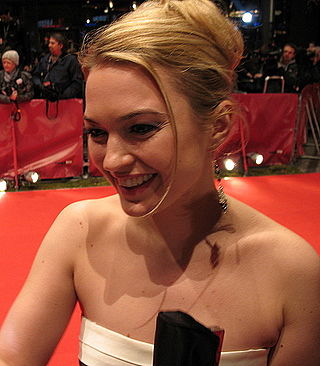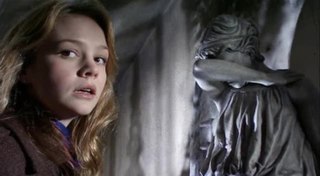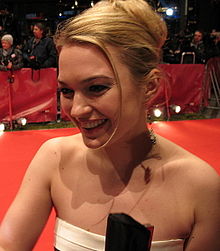
Gallifrey, is a fictional planet in the long-running British science fiction television series Doctor Who. It is the original home world of the Time Lords, the civilisation to which the protagonist, the Doctor belongs. It is located in a binary star system 250 million light years from Earth.

The Doctor is the protagonist of the long-running BBC science fiction television series Doctor Who. They are an extraterrestrial Time Lord who travels the universe in a time travelling spaceship, called the TARDIS, often with companions. Since the show's inception in 1963, the character has been portrayed by fourteen lead actors. The transition to each succeeding actor is explained within the show's narrative through the plot device of regeneration, a biological function of Time Lords that allows a change of cellular structure and appearance with recovery following a mortal injury.

Sophia Myles is an English actress. She is best known in film for portraying Lady Penelope Creighton-Ward in Thunderbirds (2004), Isolde in Tristan & Isolde (2006), Darcy in Transformers: Age of Extinction (2014), Erika in Underworld (2003) and Underworld: Evolution (2006) and Freya in Outlander (2008).
"The Christmas Invasion" is a 60-minute special episode of the British science fiction television programme Doctor Who, first broadcast on BBC One on 25 December 2005. It was written by showrunner and executive producer Russell T Davies and was directed by James Hawes.
"Tooth and Claw" is the second episode of the second series of the British science fiction television series Doctor Who, which was first broadcast on BBC One on 22 April 2006.

"Doomsday" is the thirteenth and final episode in the second series of the revival of the British science fiction television programme Doctor Who. It was first broadcast on 8 July 2006 and is the conclusion of a two-part story; the first part, "Army of Ghosts", was broadcast on 1 July 2006. The two-part story features the Daleks, presumed extinct after the events of the 2005 series' finale, and the Cybermen, who appeared in a parallel universe in the 2006 episodes "Rise of the Cybermen" and "The Age of Steel". Both species unexpectedly arrive on Earth at the conclusion of "Army of Ghosts".

"Love & Monsters" is the tenth episode of the second series of the British science fiction television series Doctor Who, which was first broadcast on BBC One on 17 June 2006. It was written by executive producer and lead writer Russell T Davies and directed by Dan Zeff.
"The Runaway Bride" is a special episode of the long-running British science fiction television programme Doctor Who, starring David Tennant as the Tenth Doctor. It was produced as the Doctor Who Christmas special for 2006, broadcast on 25 December, and aired between the second and third series of the relaunched show.
The Time Lords are a fictional humanoid species originating on the planet Gallifrey, seen in the British science fiction television series Doctor Who. They are called "Time Lords" because of their ability to travel in and manipulate time through prolonged exposure to the time vortex.

"Blink" is the tenth episode of the third series of the British science fiction television series Doctor Who. It was first broadcast on 9 June 2007 on BBC One. The episode was directed by Hettie MacDonald and written by Steven Moffat. The episode is based on a previous short story written by Moffat for the 2006 Doctor Who Annual, entitled "'What I Did on My Christmas Holidays' By Sally Sparrow".

"Voyage of the Damned" is an episode of the British science fiction television programme Doctor Who. First broadcast on BBC One on 25 December 2007, it is the third Doctor Who Christmas special since the show's revival in 2005. The episode was written by Russell T Davies and directed by James Strong.
"Silence in the Library" is the eighth episode of the fourth series of the revived British science fiction television series Doctor Who. It was first broadcast on BBC One on 31 May 2008. It is the first of a two-part story; the second part, "Forest of the Dead", aired on 7 June. The two episodes make up the second two-parter Steven Moffat contributed to the series after "The Empty Child" and "The Doctor Dances" from the first series. It is also the final story that Moffat wrote before replacing Russell T Davies as head writer and showrunner starting from the fifth series in 2010.
"The Doctor's Daughter" is the sixth episode of the fourth series of British science fiction television series Doctor Who. It was broadcast on BBC One on 10 May 2008.

The second series of British science fiction programme Doctor Who began on 25 December 2005 with the Christmas special "The Christmas Invasion". A regular series of thirteen episodes was broadcast weekly in 2006, starting with "New Earth" on 15 April and concluding with "Doomsday" on 8 July. In addition, two short special episodes were produced; a Children in Need special and an interactive episode, as well as thirteen minisodes titled Tardisodes. It is the second series of the revival of the show, and the twenty-eighth season overall.

River Song is a fictional character created by Steven Moffat and played by Alex Kingston in the British science-fiction series Doctor Who. River Song was introduced to the series as an experienced future companion of series protagonist the Doctor, an alien Time Lord who travels through time in his TARDIS. Because River Song is a time traveller herself, her adventures with the Doctor occur out of synchronisation; their first meeting is with the Tenth Doctor, the Doctor's first and apparently her last. Kingston plays her in 15 episodes, as River becomes a companion, romantic interest and eventual wife of the Doctor in his eleventh incarnation portrayed by Matt Smith. From a production perspective, the Twelfth Doctor is the last incarnation to meet her, spending a 24-year-long night with her, before her first meeting with the Tenth Doctor. From the timeline perspective, the final time River meets with the Doctor, she is a hologram/echo from the library archives; she and the Eleventh Doctor part ways in the episode, "The Name of the Doctor".

"Planet of the Dead" is the first of four special episodes of the British science fiction television series Doctor Who broadcast in between mid-2009 and early 2010. It was simultaneously broadcast on BBC One and BBC HD on 11 April 2009. The specials served as lead actor David Tennant's final stories as the Tenth Doctor. He is joined in the episode by actress Michelle Ryan, who plays Lady Christina de Souza, a one-off companion to the Doctor. The episode was written by Russell T Davies and Gareth Roberts, the first co-writing credit since the show's revival in 2005. "Planet of the Dead" serves as the 200th story of Doctor Who.

The fifth series of the British science-fiction television programme Doctor Who was originally broadcast on BBC One in 2010. The series began on 3 April 2010 with "The Eleventh Hour", and ended with "The Big Bang" on 26 June 2010. The series is the first to be led by Steven Moffat, who took over as head writer and executive producer when Russell T Davies ended his involvement in the show after "The End of Time". The series has 13 episodes, six of which were written by Moffat. Piers Wenger and Beth Willis were co-executive producers, and Tracie Simpson and Peter Bennett were producers. Although it is the fifth series since the show's revival in 2005, the series' production code numbers were reset.
"The Time of Angels" is the fourth episode of the fifth series of the British science fiction television series Doctor Who, which was first broadcast on 24 April 2010 on BBC One. It is the first episode of a two-part story written by showrunner Steven Moffat and directed by Adam Smith; the second episode, "Flesh and Stone", aired on 1 May. Moffat utilised the two-part episode to bring back a couple of his previous creations: the Weeping Angels from his series three episode "Blink", and River Song from the series four episodes "Silence in the Library" and "Forest of the Dead".

"Deep Breath" is the first episode of the eighth series of the British science fiction television programme Doctor Who, first broadcast on BBC One and released in cinemas on 23 August 2014. It was written by showrunner and executive producer Steven Moffat and directed by Ben Wheatley.
"World Enough and Time" is the eleventh and penultimate episode of the tenth series of the British science fiction television series Doctor Who. It was written by Steven Moffat, directed by Rachel Talalay, and was broadcast on 24 June 2017 on BBC One. The episode was the first part of a two-part story, concluding with The Doctor Falls.













